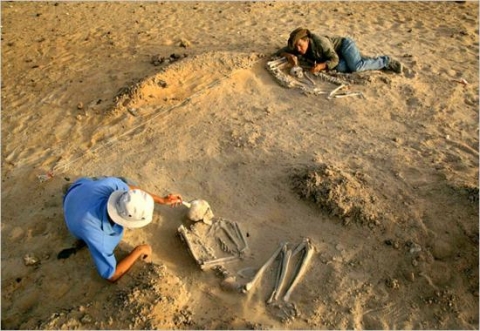Paleontology or palaeontology is the scientific study of life existent prior to, and sometimes including, the start of the Holocene Epoch roughly 11,700 years before present. It includes the study of fossils to determine organisms’ evolution and interactions with each other and their environments (their paleoecology). Paleontological observations have been documented as far back as the 5th century BC. The science became established in the 18th century as a result of Georges Cuvier’s work on comparative anatomy, and developed rapidly in the 19th century. The term itself originates from Greek palaios, i.e. “old, ancient”, on (gen. ontos), i.e. “being, creature” and logos, i.e. “speech, thought, study”.
Paleontology lies on the border between biology and geology, but differs from archaeology in that it excludes the study of morphologically modern humans. It now uses techniques drawn from a wide range of sciences, including biochemistry, mathematics and engineering. Use of all these techniques has enabled paleontologists to discover much of the evolutionary history of life, almost all the way back to when Earth became capable of supporting life, about 3,800 million years ago. As knowledge has increased, paleontology has developed specialised sub-divisions, some of which focus on different types of fossil organisms while others study ecology and environmental history, such as ancient climates.
Body fossils and trace fossils are the principal types of evidence about ancient life, and geochemical evidence has helped to decipher the evolution of life before there were organisms large enough to leave body fossils. Estimating the dates of these remains is essential but difficult: sometimes adjacent rock layers allow radiometric dating, which provides absolute dates that are accurate to within 0.5%, but more often paleontologists have to rely on relative dating by solving the “jigsaw puzzles” of biostratigraphy. Classifying ancient organisms is also difficult, as many do not fit well into the Linnean taxonomy that is commonly used for classifying living organisms, and paleontologists more often use cladistics to draw up evolutionary “family trees”. The final quarter of the 20th century saw the development of molecular phylogenetics, which investigates how closely organisms are related by measuring how similar the DNA is in their genomes. Molecular phylogenetics has also been used to estimate the dates when species diverged, but there is controversy about the reliability of the molecular clock on which such estimates depend. – WikiPedia
Paleontology is a rich field, imbued with a long and interesting past and an even more intriguing and hopeful future. Many people think paleontology is the study of fossils. In fact, paleontology is much more.
Paleontology is traditionally divided into various subdisciplines:
Micropaleontology: Study of generally microscopic fossils, regardless of the group to which they belong.
Paleobotany: Study of fossil plants; traditionally includes the study of fossil algae and fungi in addition to land plants.
Palynology: Study of pollen and spores, both living and fossil, produced by land plants and protists.
Invertebrate Paleontology: Study of invertebrate animal fossils, such as mollusks, echinoderms, and others.
Vertebrate Paleontology: Study of vertebrate fossils, from primitive fishes to mammals.
Human Paleontology (Paleoanthropology): The study of prehistoric human and proto-human fossils.
Taphonomy: Study of the processes of decay, preservation, and the formation of fossils in general.
Ichnology: Study of fossil tracks, trails, and footprints.
Paleoecology: Study of the ecology and climate of the past, as revealed both by fossils and by other methods.
In short, paleontology is the study of what fossils tell us about the ecologies of the past, about evolution, and about our place, as humans, in the world. Paleontology incorporates knowledge from biology, geology, ecology, anthropology, archaeology, and even computer science to understand the processes that have led to the origination and eventual destruction of the different types of organisms since life arose. The exhibits that we have set up here are created by paleontogists. More than just an overview of the diversity that has existed through time on this planet, the exhibits also highlight some of the research that paleontologists are conducting at the Museum of Paleontology. – UC Berkeley

